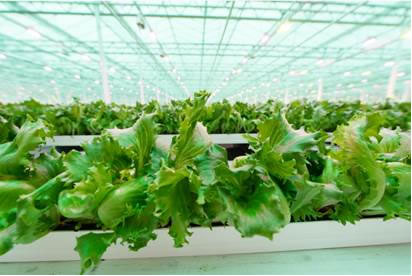Little Leaf Farms, the best-selling greenhouse grown lettuce in the US, doubles greenhouse growing capacity and broadly expands across East Coast
Little Leaf Farms, which grows the number one, best-selling crunchy baby green lettuce in the United States, is doubling its sun-drenched, greenhouse-growing capacity to 10 acres of lettuce fields under glass, producing more than two million packages of lettuce each month, and broadening distribution of the fan-favorite greens to stores across New England and into New York, New Jersey, Pennsylvania, and throughout the East Coast.

PHOTO CREDIT: ROBIN TERHUNE
“It’s been a long time coming, but we have been outselling our competitors in all the major supermarkets for years,” said Paul Sellew, founder and CEO of Little Leaf Farms which has expanded from five to 10 acres in five years. “During the pandemic, we continued to see how vital locally-grown food is to keeping people healthy. Our customers rave about the freshness of our lettuce which is harvested and shipped within 24 hours. We consistently beat our competition in California and Arizona on quality and taste, and that demand warrants this major expansion.”
The company also recently bought 180 acres of land in McAdoo, Pennsylvania and has plans to build another state-of-the-art greenhouse there to further distribution down the East Coast of the sustainably-grown lettuce, produced without chemical pesticides, herbicides, or fungicides and with pure sunlight and captured rainwater.
With the global hydroponics market expected to reach $16 billion in 2025, Little Leaf Farms also plans to build a greenhouse in North Carolina. Optimistic about the company’s strong financial prospects and projected growth, Bank of America has supplied significant funding for this expansion.
“The way in which we grow acres of fresh lettuce under glass with natural sunlight and captured rainwater is the way of the future,” Sellew said. “The pandemic has shown us that we need strong local food systems to make our communities more resilient and improve the freshness and quality of produce. We are part of the nation’s critical infrastructure.”
Food production is responsible for approximately 26 percent of global GHG emissions, and 40 percent of food production ends up as waste either from supply chain losses or consumers. With increasing population and concerns about resiliency, climate change and food insecurity, local, hydroponic growing is a viable solution to combating food waste and providing food more sustainably and efficiently.
Little Leaf Farms disrupts the long-standing practice of growing and trucking 95 percent of the nation’s leafy greens more than 3,000 miles across the country from California and Arizona particularly at a time when wildfires, drought, and climate change are impacting growers in California. Instead, Little Leaf Farms’ greens are locally harvested and shipped to stores within 24 hours so they are fresher and maintain a longer shelf life.
By growing under glass, there is no risk of contamination because no human hands ever touch the lettuce, and the greens are not exposed to animal waste like outdoor field-grown lettuce, eliminating the hazard of E. coli, a common problem every year in field-grown lettuces in California.
With each phase of expansion, Sellew and his team are adapting and integrating the world’s best technology into its greenhouses, including the latest energy efficiency technology in heating, cooling and lighting, advanced data analytics, and the next generation of hands-free automated grow systems.
Sustainability has been at the core of Little Leaf Farms growing system from the beginning. Distinguishing aspects of Little Leaf Farms’ sustainable growing methods, include:
- Hydroponic production – growing without soil – naturally protects increasingly stressed topsoil that is vulnerable to soil erosion, an increasing problem in agriculture today. This precise, soil-less method utilizes up to 90 percent less water than field-grown greens to grow crunchy, flavorful lettuce. Lettuce is also being grown in peat in the new greenhouse.
- Lettuce is grown with 100 percent captured rainwater and natural sunlight through special high-light transmission glass windows.
- Captured rainwater is treated naturally with UV light before it is used to hydrate the plants.
- Solar panels also generate significant amount of electricity, and Little Leaf Farms burns clean natural gas to heat the greenhouse and captures the CO2 and releases it back into the greenhouse.
- Little Leaf Farms’ Nutrient Film Technique (NFT) mobile gutter system is the most advanced in the world, delivering an approximately 20x yield increase per acre compared to traditional West Coast field agriculture and higher yields compared to other hydroponic systems.
“The East Coast is accustomed to lettuce that loses its freshness every mile it travels from the West Coast, and whether it’s the problem of COVID 19, soil erosion, wildfires, or drought, the West Coast is no longer a reliable source of fresh produce,” added Sellew. “So, Little Leaf Farms’ lettuce is a game-changer. By growing in what is called controlled environment agriculture, we have brought year-round produce back to the East Coast. It means we can all eat much fresher, tastier and crisper lettuce as a result.”
About Little Leaf Farms
Little Leaf Farms is on a mission to transform the way food is grown. Using advanced greenhouse technologies, Little Leaf Farms is growing fresh, local, sustainably farmed lettuce 365 days a year. Little Leaf Farms utilizes captured rainwater, natural sunlight that shines through high transmission glass, and solar powered energy in their precise, soil-less hydroponic farming. The crispy, flavorful baby greens are harvested without ever touching human hands and are never treated with chemical pesticides, herbicides, or fungicides. Little Leaf Farms baby lettuces are available in 4oz and 8oz sizes throughout the East Coast.
Comments (0)
This post does not have any comments. Be the first to leave a comment below.
Featured Product

